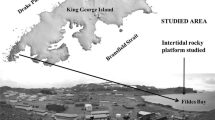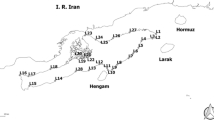Abstract
Rocky intertidal algae harbor a diverse invertebrate meiofauna of arthropods, nematodes and other invertebrates. Despite its ecological importance, relatively little is known about the diversity and composition of this important component of intertidal biodiversity. In this study, we quantified species composition, abundance and distribution of ostracodes, an important group of phytal meiofauna, at two different intertidal areas in southern California. In total, we recovered 22 ostracode species from three different orders (16 podocopids, five myodocopids and one platycopid), nearly a quarter of which could not be assigned to existing taxa. The abundance of ostracodes differed significantly among algal types, with structurally complex algae bearing many more ostracodes per gram of algae than simple forms (blade-like algae and the surfgrass Phyllospadix). Although most ostracode species were recovered from multiple kinds of algae, different algae harbored distinct assemblages that could be discriminated statistically on the basis of relative abundances of ostracode species. This segregation of the ostracode fauna according to algal species is evident even over very short spatial scales (<1 m). Finally, ostracode samples from turf-forming algae were more species rich than samples from other kinds of macroalgae. Since turf-forming algae are easily damaged by human trampling, this component of ostracode biodiversity may be particularly vulnerable to anthropogenic impacts on the intertidal habitat.




Similar content being viewed by others
References
Abbott, I. A. & G. J. Hollenberg, 1976. Marine Algae of California. Stanford University Press, Stanford, 827 pp.
Addessi, L., 1994. Human disturbance and long-term changes on a rocky intertidal community. Ecological Applications 4: 786–797.
Athersuch, J., 1979. The ecology and distribution of the littoral ostracods of Cyprus. Journal of Natural History 13: 135–160.
Athersuch, J., D. J. Horne & J. E. Whittaker, 1989. Marine and Brackish Water Ostracods. The Bath Press, Avon, 343 pp.
Benson, R. H., 1959. Ecology of Recent ostracodes of the Todos Santos Bay regions, Baja California, Mexico. University of Kansas Paleontological Contributions Monograph 1: 1–80.
Benson, R. H. & R. L. Kaesler, 1963. Recent marine and lagoonal ostracodes from the Estero de Tastiota region, Sonora, Mexico (Northeastern Gulf of California). University of Kansas Paleontological Contributions Monograph 3: 1–34.
Brosnan, D. M. & L. L. Crumrine, 1994. Effects of human trampling on marine rocky shore communities. Journal of Experimental Marine Biology and Ecology 177: 79–97.
Brouwers, E. M., 1990. Systematic paleontology of Quaternary ostracode assemblages from the Gulf of Alaska. Part 1. Families Cytherellidae, Bairdiidae, Cytheridae, Leptocytheridae, Limnocytheridae, Eucytheridae,Krithidae, Cushmanideidae. United States Geological Survey Professional Paper P1510: 1–43.
Brouwers, E. M., 1993. Systematic paleontology of Quaternary ostracode assemblages from the Gulf of Alaska. Part 2. Families Trachyleberididae, Hemicytheridae, Loxoconchidae, Paracytherideidae. United States Geological Survey Professional Paper P1531: 1–47.
Brouwers, E. M., 1994. Systematic paleontology of Quaternary ostracode assemblages from the Gulf of Alaska. Part 3. Family Cytheruridae. United States Geological Survey Professional Paper P1544: 1–45.
Brown, P. J. & R. B. Taylor, 1999. Effects of trampling by humans on animals inhabiting coralline algal turf in the rocky intertidal. Journal of Experimental Marine Biology and Ecology 235: 45–53.
Caramujo, M.-J., E. Van der Grinten & W. Admiraal, 2005. Trophic interactions between benthic copepods and algal assemblages: a laboratory study. Journal of the North American Benthological Society 24: 890–903.
Clarke, K. R. & H. Green, 1988. Statistical design and analysis for a ‘biological effects’ study. Marine Ecology Progress Series 46: 213–226.
Coull, B. C. & J. B. J. Wells, 1983. Refuges from fish predation: experiments with phytal meiofauna from the New Zealand rocky intertidal. Ecology 64: 1599–1609.
Crouch, R. W., 1949. Pliocene Ostracoda from southern California. Journal of Paleontology 23: 594–599.
Elofson, O., 1941. Zur Kenntnis der marinen Ostracoden Schwedems mit Besonderer Berucksichtigung des Skageraks. Zoologiska Bidrag fran Uppsala 19: 215–534.
Gee, J. M., 1989. An ecological and economic review of meiofauna as food for fish. Zoological Journal of the Linnean Society 96: 243–261.
Gerlach, S. A., 1978. Food-chain relationships in subtidal silty sand marine sediments and the role of meiofauna in stimulating bacterial productivity. Oecologia 33: 55–69.
Gotelli, N. J. & G. L. Entsminger, 2006. EcoSim: Null models software for ecology. Acquired Intelligence Inc. & Kesey-Bear, v. 7.
Hagerman, L., 1966. The macro- and microfauna associated with Fucus serratus L., with some ecological remarks. Ophelia 3: 1–43.
Hagerman, L., 1968. The ostracod fauna of Corallina officinalis L. in western Norway. Sarsia 36: 49–54.
Hartmann, V. G., 1959. Zur Kenntnis der lotischen Lebenbereiche der pazifischen Küste von El Salvador unter besonderer Berücksichtigung seiner Ostracodenfauna. Kieler Meeresforsch 15: 187–241.
Hicks, G. R. F., 1986. Meiofauna associated with rocky shore algae. In Moore, P. G. & R. Seed (eds), The Ecology of Rocky Coasts. Columbia University Press, New York, 36–56.
Horne, D. J., 1982. The vertical distribution of phytal ostracodes in the intertidal zone at Gore Point, Bristol Channel, U.K. Journal of Micropalaeontology 1: 71–84.
Horne, D. J., 2003. Key events in the ecological radiation of the Ostracoda. In Park, L. E. & A. J. Smith (eds), Bridging the Gap: Trends in the Ostracode Biological and Geological Sciences. Yale University Reprographics and Imaging Services, New Haven, 181–201.
Horne, D. J. & J. E. Whittaker, 1985. A revision of the genus Paradoxostoma Fischer (Crustacea; Ostracoda) in British waters. Zoological Journal of the Linnean Society 85: 131–203.
Horne, D. J., A. Cohen & K. Martens, 2002. Taxonomy, morphology and biology of quaternary and living Ostracoda. In Holmes, J. A. & A. R. Chivas (eds), The Ostracoda. Applications in Quaternary Research. American Geophysical Union, Washington, DC.
Hull, S. L., 1997. Seasonal changes in diversity and abundance of ostracods on four species of intertidal algae with differing structural complexity. Marine Ecology Progress Series 161: 71–82.
Hull, S. L., 1998. The distribution and assemblage composition of the ostracod fauna (Crustacea: Ostracoda) on Filey Brigg, North Yorkshire. Journal of Natural History 32: 501–520.
Hull, S. L., 1999a. Comparison of tidepool phytal ostracod abundance and assemblage structure on three spatial scales. Marine Ecology Progress Series 182: 201–208.
Hull, S. L., 1999b. Intertidal ostracod (Crustacea: Ostracoda) abundance and assemblage structure within and between four shores in north-east England. Journal of the Marine Biological Association of the United Kingdom 79: 1045–1052.
Kamiya, T., 1988. Morphological and ethological adaptations of Ostracoda to microhabitats in Zostera beds. In Hanai, T., N. Ikeya & K. Ishizaki (eds), Evolutionary Biology of Ostracoda. Elsevier, Kodansha, Japan, 303–318.
Keough, M. J. & G. P. Quinn, 1998. Effects of periodic disturbances from trampling on rocky intertidal algal beds. Ecological Applications 8: 141–161.
Kornicker, L. S. & B. Myers, 1981. Rutidermatidae of southern California (Ostracoda: Myocopina). Smithsonian Contributions to Zoology 334: 1–35.
Le Roy, L. W., 1943. Pleistocene and Pliocene Ostracoda of the coastal region of southern California. Journal of Paleontology 17: 354–373.
Legendre, L. & P. Legendre, 1983. Numerical Ecology. Elsevier Scientific Publishing, Amsterdam, 419 pp.
Maddocks, R. F., 1969. Revision of recent Bairdiidae (Ostracoda). United States National Museum Bulletin 295: 1–126.
Maddocks, R. F., 1990. Living and fossil Macrocyprididae (Ostracoda). University of Kansas Paleontological Contributions Monograph 2: 1–285.
Magurran, A. E., 2004. Measuring Biological Diversity. Blackwell Publishing, Oxford, 256 pp.
McKenzie, K. G., 1965. Myodocopid Ostracoda (Cyprinacea) from Scammon Lagoon, Baja California, Mexico, and their ecologic associations. Crustaceana 9: 5–70.
McKenzie, K. G. & F. M. Swain, 1967. Recent Ostracoda from Scammon Lagoon, Baja California. Journal of Paleontology 41: 281–305.
Moore, C. G. & B. J. Bett, 1989. The use of meiofauna in marine pollution impact assessment. Zoological Journal of the Linnean Society 96: 263–280.
Nohara, T. & R. Tabuki, 1990. Seasonal distribution of Ostracoda on two species of marine plants and two holothurians in Okinawa, Japan. In Whatley, R. & C. Maybury (eds), Ostracoda and Global Events. Chapman & Hall, London, 355–363.
Oksanen, J., R. Kindt & B. O’Hara, 2005. Vegan: community ecology package. v. 1.6–10.
Poulsen, E. M., 1965. Ostracoda-Myodocopa, 2: Cypridiniformes-Rutidermatidae, Sarsiellidae and Asteropidae. Dana Report 65: 1–484.
R Development Core Team, 2005. R: A language and environment for statistical computing. R Foundation for Statistical Computing, v. 2.1.1.
Roy, K., A. G. Collins, B. J. Becker, E. Begovic & J. M. Engle, 2003. Antropogenic impacts and historical decline in body size of rocky intertidal gastropods in southern California. Ecology Letters 6: 205–211.
Ruiz, F., M. Abad, A. M. Bodergat, P. Carbonel, J. Rodriguez-Lazaro & M. Yasuhara, 2005. Marine and brackish-water ostracods as sentinels of anthropogenic impacts. Earth-Science Reviews 72: 89–111.
Sanders, H. L., 1968. Marine benthic diversity: a comparative study. American Naturalist 102: 243–282.
Skogsberg, T., 1928. Studies on marine ostracods. Part II. External morphology of the genus Cythereis, with descriptions of twenty-one new species. California Academy of Science, Occasional Papers 15.
Skogsberg, T., 1950. Two new species of marine Ostracoda (Podocopa) from California. Proceedings of the California Academy of Sciences 26: 483–505.
Smith, V. Z., 1952. Further Ostracoda of the Vancouver Island region. Journal of the Fisheries Research Board of Canada 9: 16–41.
Sokal, R. R. & F. J. Rohlf, 1995. Biometry. W.H. Freeman & Company, New York, 887 pp.
Swain, F. M., 1967. Ostracoda from the Gulf of California. Geological Society of America Memoir 101: 1–139.
Swain, F. M., 1969. Taxonomy and ecology of near-shore Ostracoda from the Pacific coast of North and Central America. In Neale, J. W. (ed.), The Taxonomy, Morphology and Ecology of Recent Ostracoda. Oliver & Boyd, Edinburgh, 423–474.
Swain, F. M. & J. M. Gilby, 1967. Recent Ostracoda from Corinto Bay, western Nicaragua, and their relationship to some other assemblages of the Pacific Coast. Journal of Paleontology 41: 306–334.
Swain, F. M. & J. M. Gilby, 1974. Marine Holocene Ostracoda from the Pacific coast of North and Central America. Micropaleontology 20: 257–353.
Valentine, P. C., 1976. Zoogeography of Holocene Ostracoda off western North America and paleoclimatic implications. United States Geological Survey Professional Paper 916: 1–47.
Watzin, M. C., 1983. The effects of meiofauna on settling macrofauna: meiofauna may structure macrofaunal communities. Oecologia 59: 163–166.
Whatley, R. C. & D. R. Wall, 1975. The relationship between Ostracoda and algae in littoral and sublittoral marine environments. Bulletin of the American Paleontological Society 65: 173–203.
Williams, R., 1969. Ecology of the Ostracoda from selected marine intertidal localities on the coast of Anglesey. In Neale, J. W. (ed.), The Taxonomy, Morphology and Ecology of Recent Ostracoda. Oliver & Boyd, Edinburgh, 299–329.
Acknowledgements
We thank D. Horne and an anonymous reviewer for careful and constructive comments on the manuscript, and B. Pister for advice on field collection and algae identification. A. Cohen and D. Horne generously helped us to sort out aspects of ostracode taxonomy and sbiology.
Author information
Authors and Affiliations
Corresponding author
Additional information
Handling editor: K. Martens
Electronic supplementary material
Below are the electronic supplementary materials.
Rights and permissions
About this article
Cite this article
Frame, K., Hunt, G. & Roy, K. Intertidal meiofaunal biodiversity with respect to different algal habitats: a test using phytal ostracodes from Southern California. Hydrobiologia 586, 331–342 (2007). https://doi.org/10.1007/s10750-007-0707-5
Received:
Revised:
Accepted:
Published:
Issue Date:
DOI: https://doi.org/10.1007/s10750-007-0707-5




